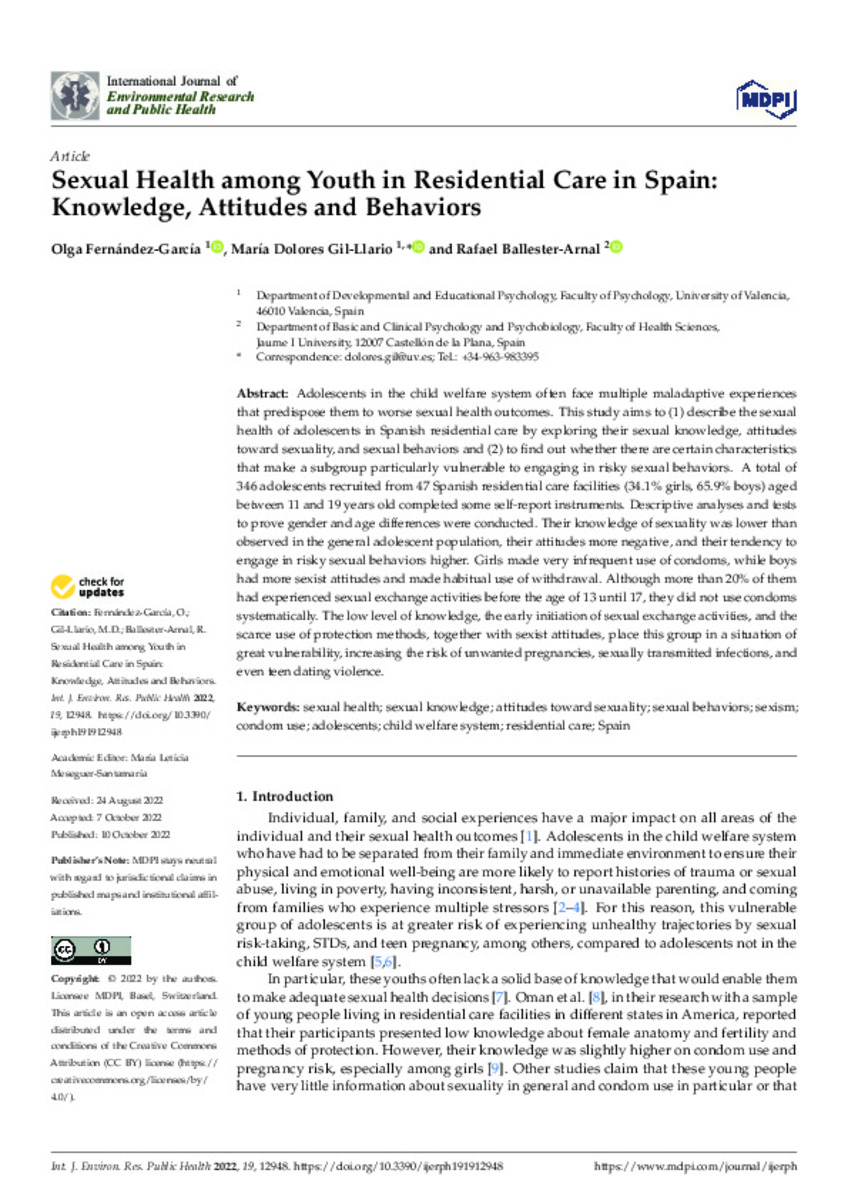Mostrar el registro sencillo del ítem
Sexual Health among Youth in Residential Care in Spain: Knowledge, Attitudes and Behaviors
| dc.contributor.author | Ballester-Arnal, Rafael | |
| dc.contributor.author | Fernández-García, Olga | |
| dc.contributor.author | Gil-Llario, MD | |
| dc.date.accessioned | 2023-03-28T09:23:13Z | |
| dc.date.available | 2023-03-28T09:23:13Z | |
| dc.date.issued | 2022-10 | |
| dc.identifier.citation | Fernández-García, O.; Gil-Llario, M.D.; Ballester-Arnal, R. Sexual Health among Youth in Residential Care in Spain: Knowledge, Attitudes and Behaviors. Int. J. Environ. Res. Public Health 2022, 19, 12948. | ca_CA |
| dc.identifier.uri | http://hdl.handle.net/10234/202081 | |
| dc.description.abstract | Adolescents in the child welfare system often face multiple maladaptive experiences that predispose them to worse sexual health outcomes. This study aims to (1) describe the sexual health of adolescents in Spanish residential care by exploring their sexual knowledge, attitudes toward sexuality, and sexual behaviors and (2) to find out whether there are certain characteristics that make a subgroup particularly vulnerable to engaging in risky sexual behaviors. A total of 346 adolescents recruited from 47 Spanish residential care facilities (34.1% girls, 65.9% boys) aged between 11 and 19 years old completed some self-report instruments. Descriptive analyses and tests to prove gender and age differences were conducted. Their knowledge of sexuality was lower than observed in the general adolescent population, their attitudes more negative, and their tendency to engage in risky sexual behaviors higher. Girls made very infrequent use of condoms, while boys had more sexist attitudes and made habitual use of withdrawal. Although more than 20% of them had experienced sexual exchange activities before the age of 13 until 17, they did not use condoms systematically. The low level of knowledge, the early initiation of sexual exchange activities, and the scarce use of protection methods, together with sexist attitudes, place this group in a situation of great vulnerability, increasing the risk of unwanted pregnancies, sexually transmitted infections, and even teen dating violence. | ca_CA |
| dc.format.extent | 14 p. | ca_CA |
| dc.format.mimetype | application/pdf | ca_CA |
| dc.language.iso | eng | ca_CA |
| dc.publisher | MDPI | ca_CA |
| dc.relation.isPartOf | Int. J. Environ. Res. Public Health 2022, 19(19), 12948 | ca_CA |
| dc.rights | © 2022 by the authors | ca_CA |
| dc.rights.uri | http://creativecommons.org/licenses/by/4.0/ | ca_CA |
| dc.subject | sexual health | ca_CA |
| dc.subject | sexual knowledge | ca_CA |
| dc.subject | sexual behaviors | ca_CA |
| dc.subject | condom use | ca_CA |
| dc.subject | adolescents | ca_CA |
| dc.subject | child welfare system | ca_CA |
| dc.subject | residential care | ca_CA |
| dc.subject | Spain | ca_CA |
| dc.title | Sexual Health among Youth in Residential Care in Spain: Knowledge, Attitudes and Behaviors | ca_CA |
| dc.type | info:eu-repo/semantics/article | ca_CA |
| dc.identifier.doi | https://doi.org/10.3390/ijerph191912948 | |
| dc.rights.accessRights | info:eu-repo/semantics/openAccess | ca_CA |
| dc.relation.publisherVersion | https://www.mdpi.com/1660-4601/19/19/12948 | ca_CA |
| dc.type.version | info:eu-repo/semantics/publishedVersion | ca_CA |
| project.funder.name | Generalitat Valenciana | ca_CA |
| project.funder.name | Universitat de València | ca_CA |
| oaire.awardNumber | AICO/2021/143 | ca_CA |
| oaire.awardNumber | UV-INV_ETICA-1240597 | ca_CA |
Ficheros en el ítem
Este ítem aparece en la(s) siguiente(s) colección(ones)
-
PSB_Articles [1312]
Articles de publicacions periòdiques








